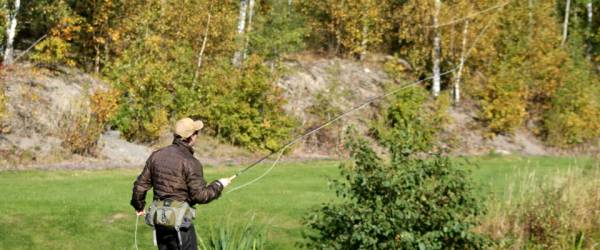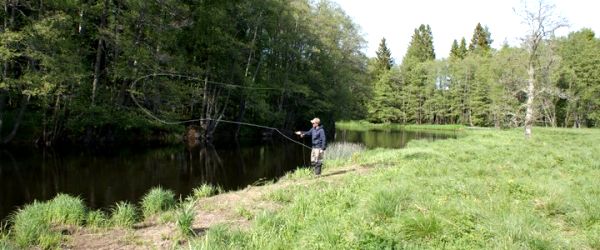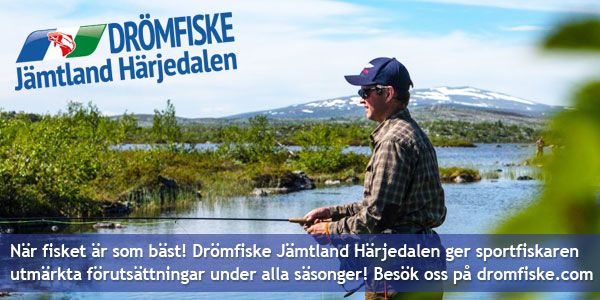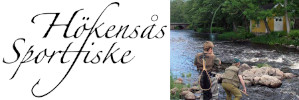Användarmeny
Fly fishing (one handed) Overview
Fly fishing (one handed)
A great method of fishing with many possibilities.
The Basics
Fly-fishing may at first sight seem awkward, especially if it stands as spectators and never have done it myself. However, there are many dimensions in fly fishing and catching fish, yes, it can do with the most basic knowledge and some practice, of course.
Unlike example. spin fishing where the bait is the weight to be able to throw out the line is the weight in fly fishing. And to get a good fly cast so it is important to use the right technique. We go through the basics.
The most important fly fishing overhand throw is to use the calm but firm movements and timing the transmission from spot to line the right way. Taking more usually results in no longer throw, technology and stops the other hand, allows you to throw checked and far, if required.
When you start with fly fishing, it is also very important that you constantly strive to have a straight spögång, ie, the rod must always go in the same line. In order to facilitate a straight spölinje can film himself when throwing to identify wrong doing and causing a warped spölinje. One can also take a little time and check the punch, that is, how to stand when throwing. If you are right-handed and throws right arm usually easier to stand with the right leg in front, this eliminates the body of rotation which is often the culprit that one does not throw in the line. To clarify what I mean by spölinje, thinking that you will be filmed from above, then goes rod in a straight line or or drag it to the right or left in any of the throws moments?
There are two very important rules in fly fishing, and follow these, you will develop rapidly.
The first rule is the stop in front & bakkastet. When fly fishing as you work out the line to length and then make the final outlay to send out the remaining line (which is removed from the roll), it "pushes out the cord" on the fly language.
The stops, is where you will stay with the rod and let readymade turn over until it is stretched horizontally, should lie at approx. One in the front and at the stop. 11 of the backstop. This eliminates many beginners mistake that could occur, such as the classic "half moon" with the line as a semicircle due for late stop.
Rule number 2, which also eliminates the classic mistakes, is that you should strive to use as little wrists as possible. Many people believe that you get extra power if you use your wrists in the decisive moments, but what happens is that you break the rope line and acceleration with a sharp movement of the wrist.
Imagine fly rod should be an extension of your arm, you decide when to break this movement with a bent wrist will throw fail. A very simple rule to remember for this purpose is to imagine that you hit a nail into a wall with a hammer, the same motion that you make with the hammer will you do with the fly rod on the forward cast. You can also tape the wrist to the spot, or buy Velcro to simply force yourself to use less wrist movement.
Good luck!
Equipment
At the far end of the roll so it has been known as a backing line, often made of braided line or "Dacron" as it is called. It has the function to act as a sort of safety rope if you get on a really big fish that takes a lot of rope.
After the backup, then the fly line that is usually in the range 25-33 meters in length. It is available in different densities as floating, sinking and slowly sinking. Fly line is currently active in two main versions: WF ( "Weight Forward") and DT ( "Double taper"). A Weight Forward line is a line that is designed so that the largest weight is at the front. The cord has a so-called lump, which vary in length, and linprofil weight. The advantage of a WF is that the rod loads faster and you do not have to work out the cord ii long drawn-out movements to get enough rope. The DT line is uniformly tapered, thus it has no lump. This line has the advantages that it can present flies in a peaceful way without lots of splashing, it is seen as slightly more technical when you do not have a thick clump far out, but you can also use both ends of the rope (because it is solid) . Thus one can when one end start to become unwell, just switch sides on the rope. WF is undoubtedly the most popular today.
A fly line you choose for which rod you have and what kind of roll you want to perform. There are an incredible number of different lines to choose from, mostly, it differs in how the profile of the line is designed.
At the end of the fly line, you must have a leader, it is thick at the beginning and thinned by more and more, the so-called "tapered". This is important so that the power transfer will be correct in the array and the line "rolls out", usually also the fly line this linprofil. Most snoods are made of nylon, monofilament or Flourcarbon. There are various lengths of paws, but the most common length is 9 feet, the same length as the common length of a rod. At the end of the tippet and you have a 'wearing part' that it seams to, this allows you to avoid having to "eat up" the leader after many flugbyten. There are also many variations of the paws, the most common is floating but you can also buy the sinking paws which helps a lot because you do not have to buy different densities of fly line, you just replace the streamer after the desired rate of descent.
To determine which rod and line that fits into what, so we talk often about the "classification". Usually you choose the same class on the rope on the spot. A classification on a fly rod is about fishing, which you should pursue. The heavier and larger fishing flies can be cast with the higher rating. Some examples: Fishing for rainbow: Class 5-6 on the line and rod. Fishing for big trout in flowing water: Class 7-8 on the line and rod. Fishing for pike and large salmon: Class 9-10.
A flugfiskespö Apart from in different classes even in different lengths. The most common length of a normal fly fishing for game fish such is 9 feet (2.74 meters), while fishing for salmon, for example, two-handed is 11-14 feet.
The roll is in fly fishing may not be as important as the spin, because you can not use an active roll to cast your line. However act roller linförvaring and is an important part when trills fish, so it is important to choose a reel with a good brake and that it shall be in the right diameter to fit the fly line and backup. There is always a fly reel Line weights which it is capable of.
In fly-fishing as they fish mostly with fish imitations and insect imitations.
A fish imitation that is very popular is called a Streamer. Otherwise, it is as I have said insect imitations that fly fishing has become renowned for and that makes it stands out so much compared to other methods.
When it comes to insect imitations so usually divide it into various stages of an insect's life. We nymph / larva stage, Heels stage and winged insect stage.
When fishing with nymphs and larva imitations that mimic it an insect that is early in the life cycle and is still living underwater.
Good flies in this stage is Harörenymf and Pheasant Tail nymph.
When fishing with heels imitations that mimic it an insect that leaves the nymph stage and is about to break the surface film to become a winged insect.
Good flies in this stage is Superpuppan and Klinkhammer.
When one imitates a winged insect that fish man with an imitation that is supposed to be an insect that completely left the nymph stage and heels. It is a full-fledged insect.
Good flies in this stage are Europe 12, Humpy, Streaking Caddis.
Advanced tips
If the hatch very large amounts of a certain insect so the fish can be very picky (and measured). Then it can be almost impossible to match hatching.
What to do in this case is to put on a fly that completely differs from the crowd. Say it hatches large amounts of mayflies, then test with a nattsländeimitation size larger and take it home with quick jerks of the water.







